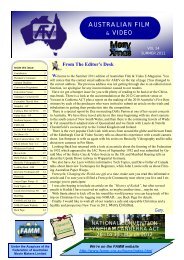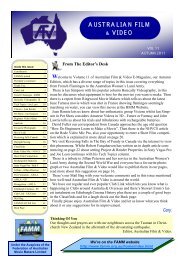4K or Quad HDWhat Is It ?As if LED and 3D TV weren't confusing enough, <strong>20</strong>12 and beyond will bringan HDTV technology called 4K. It's being heralded as the next high def, andmanufacturers are already lining up to bring you products. But just as was thecase with 3D, it's the hardware chicken before the s<strong>of</strong>tware egg: there's no consumer4K content available. Still, if you listen to the industry, it'll tell you it'sthe last resolution you'll ever need. So what is 4K anyway, and what makes itdifferent from high definition?Digital Resolutions: A primerThe latest in a line <strong>of</strong> broadcast and media resolutions, 4K is due to replace1080i/p (1,9<strong>20</strong>x1,080 pixels) as the highest-resolution signal available for moviesand, perhaps, television.When it comes out this summer,the 84-inch LG84LM9600 will be the largestLCD the market has yetseen, and one <strong>of</strong> the firstwith 4K ResolutionThough there are several different standards, "4K" in general refers to a resolution <strong>of</strong> roughly 4,000 pixelswide and about 2,000 pixels high. That makes it the equivalent <strong>of</strong> four 1080p screens in height and length.Currently 4K is a catch-all term for a number <strong>of</strong> standards that are reasonably close to that resolution, andthe TVs we'll see this year labelled 4K will actually be Quad HD, defined below.But frankly, we think 4K is the catchier name. Meanwhile, high definition (HD) itself has been with us forabout a decade and is used in Blu-ray movies and HD broadcasts.There are three versions <strong>of</strong> HD: full high definition 1080p (progressive), 1080i (interlaced), and 7<strong>20</strong>p (alsocalled simply "high definition"). Most television programs and all DVDs are encoded in standard definition(480 lines). Standard definition is the oldest resolution still in use as it began life as NTSC broadcasts,switching to digital with the introduction <strong>of</strong> ATSC in <strong>20</strong>07.Four resolutions compared: standard definition; full high definition; Quad HD; and 4K/2K. (Credit: CNET)Page 38 AUSTRALIAN FILM & VIDEO—VOL <strong>20</strong> WINTER <strong>20</strong>13
The Roots <strong>of</strong> 4K are in the TheatreWhen George Lucas was preparing to make his long-promised prequels to the "Star Wars" movies in thelate '90s, he was experimenting with new digital formats as a replacement for film. Film stock is incrediblyexpensive to produce, transport, and store. If movie houses could simply download a digital movie file anddisplay it on a digital projector, they could save a lot <strong>of</strong> money. In a time when cinemas are under siegefrom on-demand cable services and streaming video, cost-cutting helps to keep them competitive.After shooting "The Phantom Menace" partly in HD, George Lucas shot "Attack <strong>of</strong> the Clones" fully digitallyin 1080p. This was great for the future Blu-ray release, but the b<strong>of</strong>fins soon found that 1080p wasn'thigh-enough resolution for giant theatre screens. If you sit in the front rows <strong>of</strong> one <strong>of</strong> these theatres as it'sdisplaying 1080p content, you may see a s<strong>of</strong>ter image or the lattice grid <strong>of</strong> pixel structure, which can bequite distracting.The industry needed a standard that works on the proposition that you'll be sitting one-and-a-half times thescreen height from the screen, and this required a higher resolution than 1080p. Digital Cinema Initiatives(DCI) was formed in <strong>20</strong>02 with the goal <strong>of</strong> setting a digital standard. Based on these efforts, two new resolutionscame about: a 2K specification, and later in <strong>20</strong>05, the 4K format. The first high-pr<strong>of</strong>ile 4K cinemarelease was "Blade Runner: The Final Cut" in <strong>20</strong>07, a new cut and print <strong>of</strong> the 1982 masterpiece. Unfortunately,at that time very few theatres were able to show it in its full resolution. It would take one <strong>of</strong> directorRidley Scott's contemporaries to truly drive 4K into your local Cineplex.The 4K “Standard”Despite the industry's best intentions, there is still no single 4K standard-- there are five or more differentshooting resolutions available. In cinemas you see projectors based on the DCI specification. Things are alittle simpler in the home. The HDMI organization recently added two types <strong>of</strong> 4K support to its latest 1.4specification: Quad HD (3,840x2,160 pixels) and 4K/2K, also called 4Kx2K (4,096x2,160 pixels).Only Quad HD conforms to the classic 16:9 ratio <strong>of</strong>modern television screens. Meanwhile, some industryexperts have questioned the necessity <strong>of</strong> 4K as ahome format given the lack <strong>of</strong> content and the needfor very large displays to appreciate the extra resolution."There was a huge, noticeable leap from standarddefinition to HD, but the difference between1080p and 4K is not as marked," said researcher DaveLamb <strong>of</strong> 3M Laboratories. Lamb added that "4K is atthe point <strong>of</strong> diminishing returns," but there could besome benefits for screens over 55 inches.(Credit: <strong>20</strong>th Century Fox/Lucasfilm Ltd.)3D Parts <strong>of</strong> “The Phantom Menace” were shot digitally, and the film enjoyed a new lease on life in early<strong>20</strong>12 with a 3D cinema release.Did you see James Cameron's "Avatar 3D" in the theatre? Then you've seen 4K in action. Cameron's movieabout "giant blue dudes" helped drive high resolution 4K Sony projectors into theatres around the world,and made a lot <strong>of</strong> money in the process. <strong>Movie</strong> studios keen to maintain that momentum have released aslew <strong>of</strong> 3D films--mostly converted from 2D--and continued the expansion <strong>of</strong> 3D cinemas. However, thisforward motion hasn't translated to a success for 3D TV in the home. "Manufacturers would have wanted3D to be bigger than it was; they wanted it to be the next LED, but it didn't work out," Lamb said. Given aso-far-mediocre response to 3D, and the expense and bulk <strong>of</strong> active glasses, manufacturers have begun tosearch for an alternative, and 4K <strong>of</strong>fers a way to increase the quality <strong>of</strong> the 3D image with passive glassesor get rid <strong>of</strong> them altogether.Source: Stoke Cine & Video Society Newsletter #145 Autumn <strong>20</strong>12AUSTRALIAN FILM & VIDEO—VOL <strong>20</strong> WINTER <strong>20</strong>13Page 39










